Impact of Corporate Governance and Decision Making on Tax Avoidance
VerifiedAdded on 2020/03/07
|83
|25806
|495
Report
AI Summary
This report delves into the multifaceted issue of tax avoidance, exploring its relationship with corporate governance and decision-making processes. It begins by defining tax avoidance and contrasting it with tax evasion, highlighting its legal boundaries and the exploitation of loopholes. The study investigates the impact of aggressive tax planning by multinational corporations, particularly within the UK context, examining specific cases like Starbucks, Amazon, and Google. It analyzes how these companies' tax strategies affect their profitability and tax payments, comparing them to organizations that do not engage in such practices. The research also considers the implications of tax avoidance on the economy, fairness, and compliance, as well as the role of various stakeholders such as auditors and banks. The report addresses research questions concerning the UK's tax system, the costs and benefits of tax avoidance, and the strategies employed to minimize tax liabilities. Ultimately, it aims to evaluate the effects of management decisions on tax avoidance and their impact on organizations, including the resulting revenue loss for governments.

Paraphrase This Document
Need a fresh take? Get an instant paraphrase of this document with our AI Paraphraser
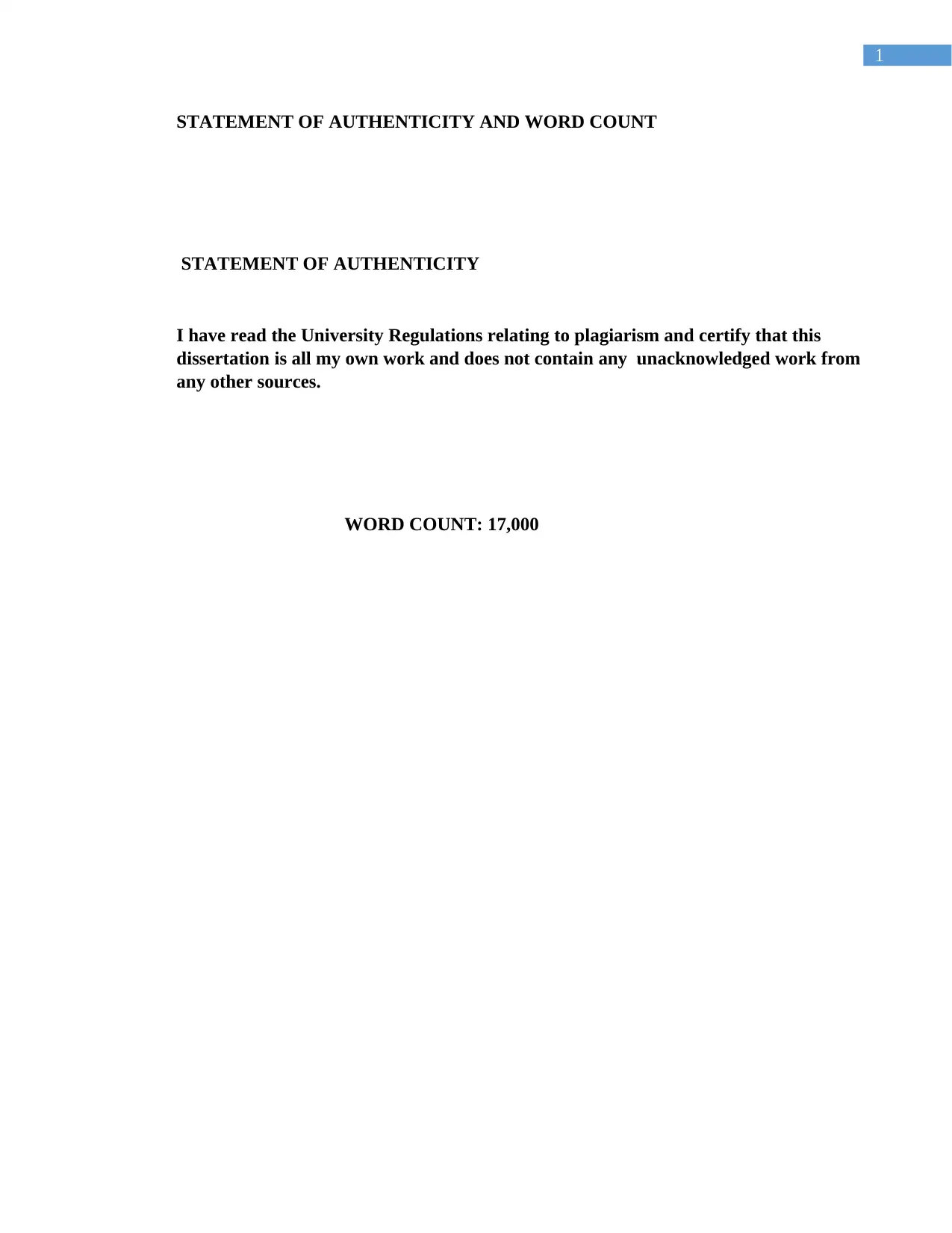
1
STATEMENT OF AUTHENTICITY AND WORD COUNT
STATEMENT OF AUTHENTICITY
I have read the University Regulations relating to plagiarism and certify that this
dissertation is all my own work and does not contain any unacknowledged work from
any other sources.
WORD COUNT: 17,000
STATEMENT OF AUTHENTICITY AND WORD COUNT
STATEMENT OF AUTHENTICITY
I have read the University Regulations relating to plagiarism and certify that this
dissertation is all my own work and does not contain any unacknowledged work from
any other sources.
WORD COUNT: 17,000
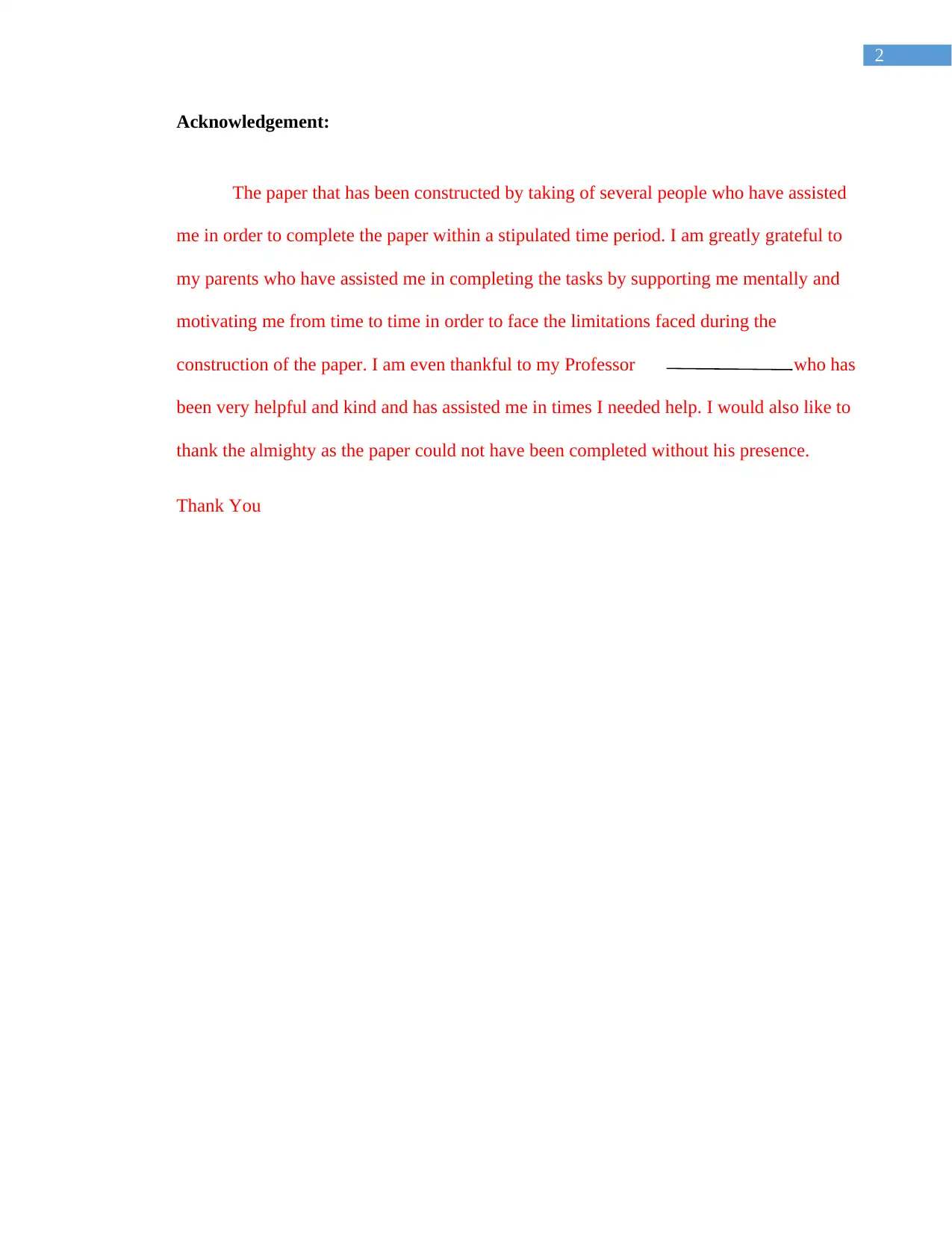
2
Acknowledgement:
The paper that has been constructed by taking of several people who have assisted
me in order to complete the paper within a stipulated time period. I am greatly grateful to
my parents who have assisted me in completing the tasks by supporting me mentally and
motivating me from time to time in order to face the limitations faced during the
construction of the paper. I am even thankful to my Professor who has
been very helpful and kind and has assisted me in times I needed help. I would also like to
thank the almighty as the paper could not have been completed without his presence.
Thank You
Acknowledgement:
The paper that has been constructed by taking of several people who have assisted
me in order to complete the paper within a stipulated time period. I am greatly grateful to
my parents who have assisted me in completing the tasks by supporting me mentally and
motivating me from time to time in order to face the limitations faced during the
construction of the paper. I am even thankful to my Professor who has
been very helpful and kind and has assisted me in times I needed help. I would also like to
thank the almighty as the paper could not have been completed without his presence.
Thank You
⊘ This is a preview!⊘
Do you want full access?
Subscribe today to unlock all pages.

Trusted by 1+ million students worldwide
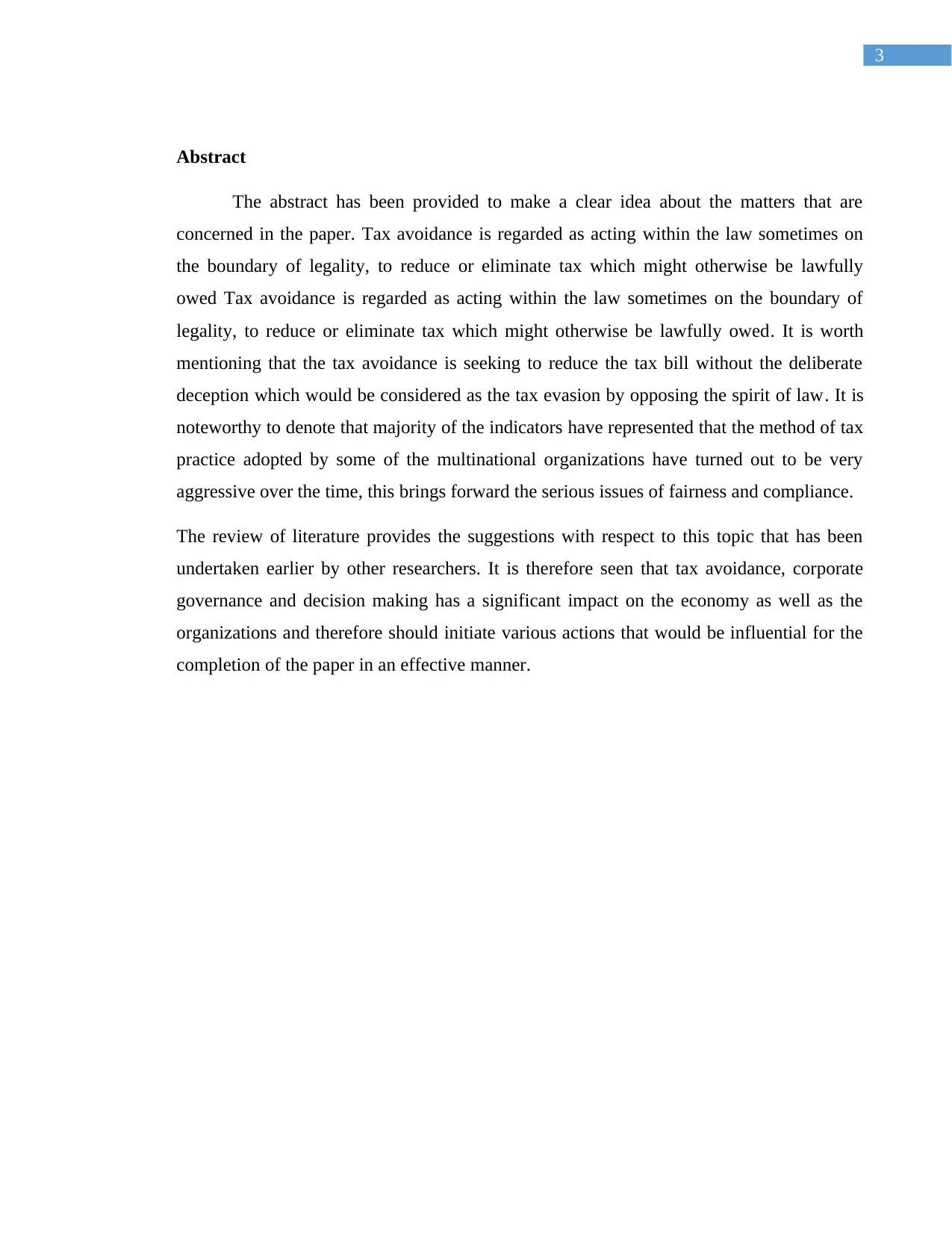
3
Abstract
The abstract has been provided to make a clear idea about the matters that are
concerned in the paper. Tax avoidance is regarded as acting within the law sometimes on
the boundary of legality, to reduce or eliminate tax which might otherwise be lawfully
owed Tax avoidance is regarded as acting within the law sometimes on the boundary of
legality, to reduce or eliminate tax which might otherwise be lawfully owed. It is worth
mentioning that the tax avoidance is seeking to reduce the tax bill without the deliberate
deception which would be considered as the tax evasion by opposing the spirit of law. It is
noteworthy to denote that majority of the indicators have represented that the method of tax
practice adopted by some of the multinational organizations have turned out to be very
aggressive over the time, this brings forward the serious issues of fairness and compliance.
The review of literature provides the suggestions with respect to this topic that has been
undertaken earlier by other researchers. It is therefore seen that tax avoidance, corporate
governance and decision making has a significant impact on the economy as well as the
organizations and therefore should initiate various actions that would be influential for the
completion of the paper in an effective manner.
Abstract
The abstract has been provided to make a clear idea about the matters that are
concerned in the paper. Tax avoidance is regarded as acting within the law sometimes on
the boundary of legality, to reduce or eliminate tax which might otherwise be lawfully
owed Tax avoidance is regarded as acting within the law sometimes on the boundary of
legality, to reduce or eliminate tax which might otherwise be lawfully owed. It is worth
mentioning that the tax avoidance is seeking to reduce the tax bill without the deliberate
deception which would be considered as the tax evasion by opposing the spirit of law. It is
noteworthy to denote that majority of the indicators have represented that the method of tax
practice adopted by some of the multinational organizations have turned out to be very
aggressive over the time, this brings forward the serious issues of fairness and compliance.
The review of literature provides the suggestions with respect to this topic that has been
undertaken earlier by other researchers. It is therefore seen that tax avoidance, corporate
governance and decision making has a significant impact on the economy as well as the
organizations and therefore should initiate various actions that would be influential for the
completion of the paper in an effective manner.
Paraphrase This Document
Need a fresh take? Get an instant paraphrase of this document with our AI Paraphraser
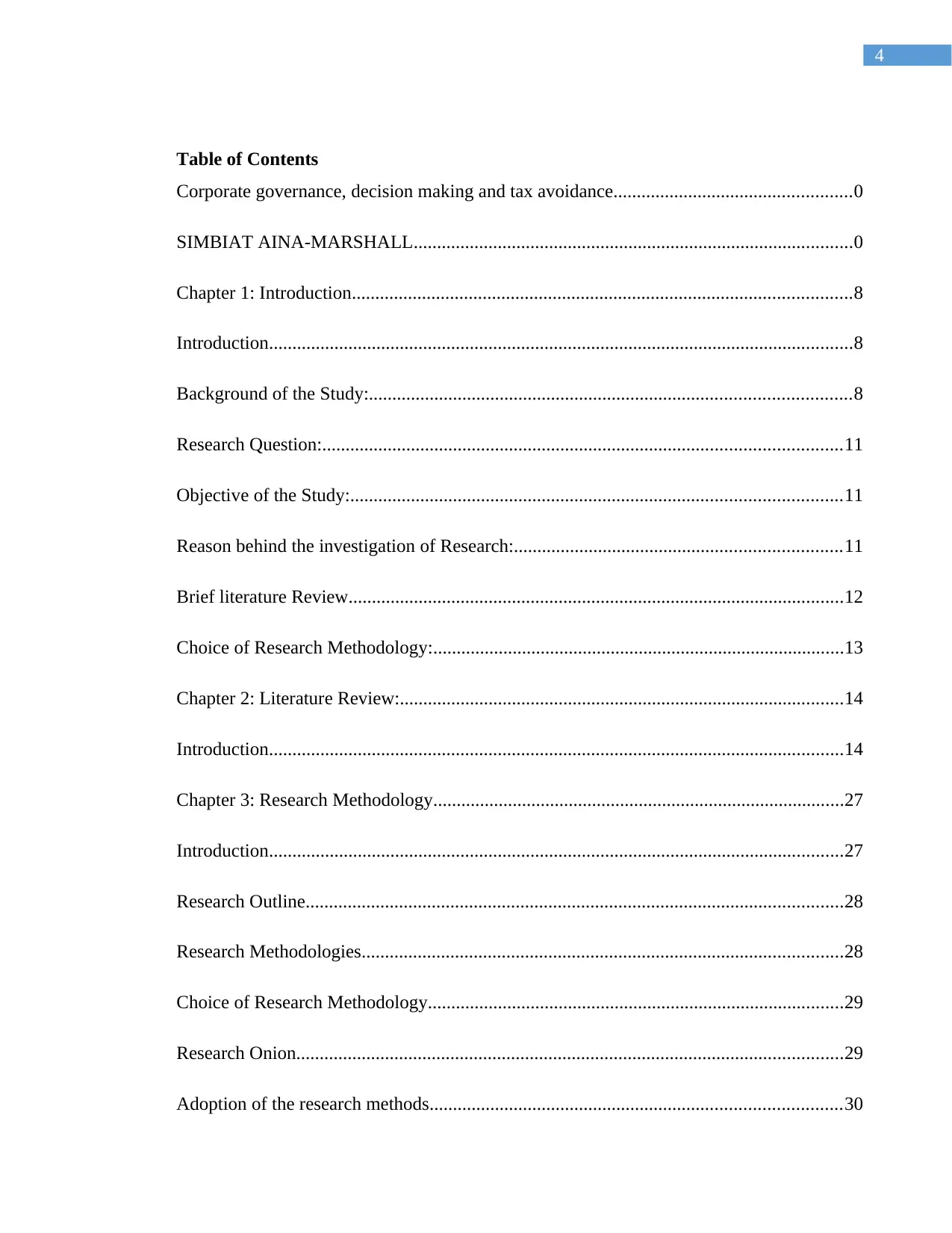
4
Table of Contents
Corporate governance, decision making and tax avoidance...................................................0
SIMBIAT AINA-MARSHALL..............................................................................................0
Chapter 1: Introduction...........................................................................................................8
Introduction.............................................................................................................................8
Background of the Study:.......................................................................................................8
Research Question:...............................................................................................................11
Objective of the Study:.........................................................................................................11
Reason behind the investigation of Research:......................................................................11
Brief literature Review..........................................................................................................12
Choice of Research Methodology:........................................................................................13
Chapter 2: Literature Review:...............................................................................................14
Introduction...........................................................................................................................14
Chapter 3: Research Methodology........................................................................................27
Introduction...........................................................................................................................27
Research Outline...................................................................................................................28
Research Methodologies.......................................................................................................28
Choice of Research Methodology.........................................................................................29
Research Onion.....................................................................................................................29
Adoption of the research methods........................................................................................30
Table of Contents
Corporate governance, decision making and tax avoidance...................................................0
SIMBIAT AINA-MARSHALL..............................................................................................0
Chapter 1: Introduction...........................................................................................................8
Introduction.............................................................................................................................8
Background of the Study:.......................................................................................................8
Research Question:...............................................................................................................11
Objective of the Study:.........................................................................................................11
Reason behind the investigation of Research:......................................................................11
Brief literature Review..........................................................................................................12
Choice of Research Methodology:........................................................................................13
Chapter 2: Literature Review:...............................................................................................14
Introduction...........................................................................................................................14
Chapter 3: Research Methodology........................................................................................27
Introduction...........................................................................................................................27
Research Outline...................................................................................................................28
Research Methodologies.......................................................................................................28
Choice of Research Methodology.........................................................................................29
Research Onion.....................................................................................................................29
Adoption of the research methods........................................................................................30
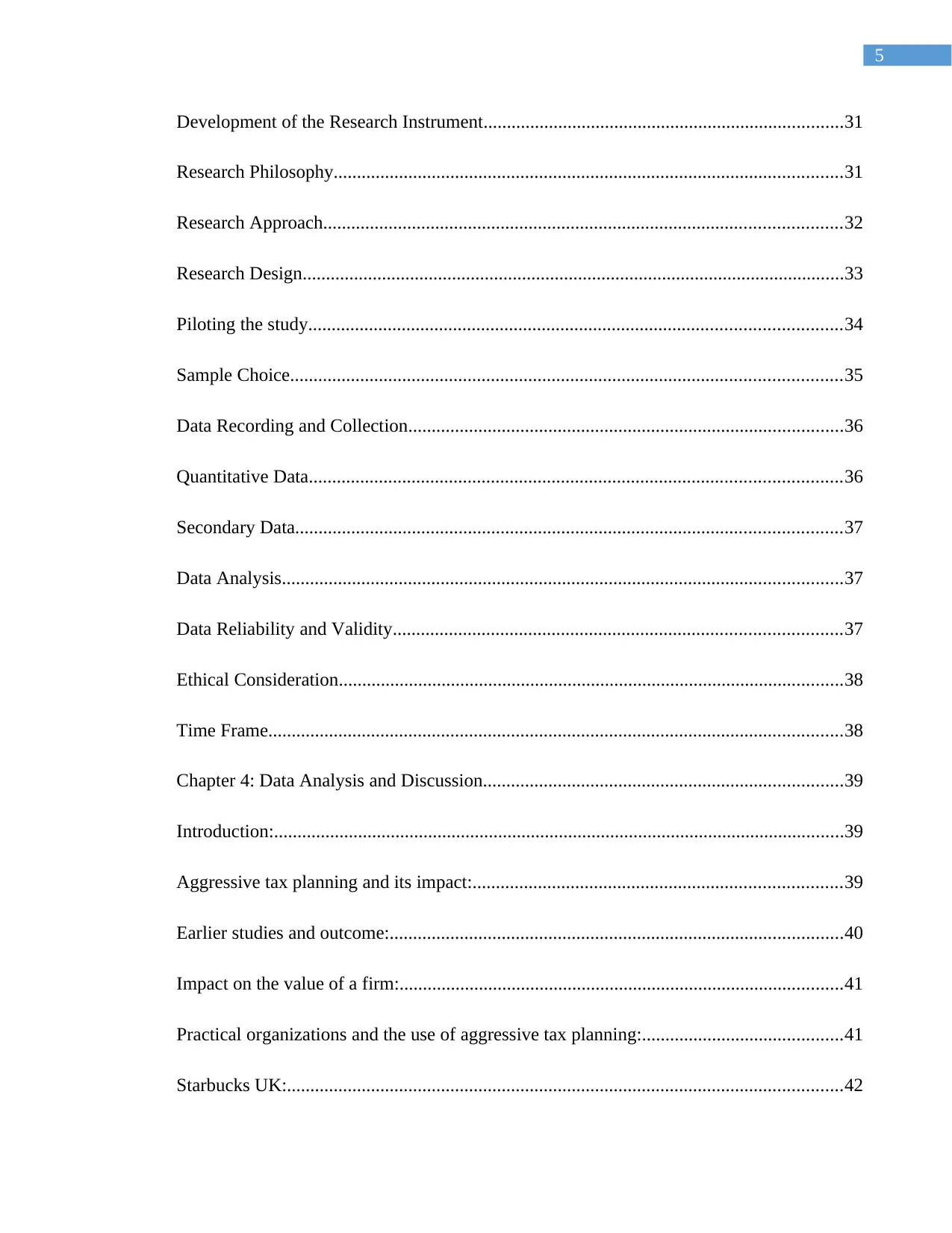
5
Development of the Research Instrument.............................................................................31
Research Philosophy.............................................................................................................31
Research Approach...............................................................................................................32
Research Design....................................................................................................................33
Piloting the study..................................................................................................................34
Sample Choice......................................................................................................................35
Data Recording and Collection.............................................................................................36
Quantitative Data..................................................................................................................36
Secondary Data.....................................................................................................................37
Data Analysis........................................................................................................................37
Data Reliability and Validity................................................................................................37
Ethical Consideration............................................................................................................38
Time Frame...........................................................................................................................38
Chapter 4: Data Analysis and Discussion.............................................................................39
Introduction:..........................................................................................................................39
Aggressive tax planning and its impact:...............................................................................39
Earlier studies and outcome:.................................................................................................40
Impact on the value of a firm:...............................................................................................41
Practical organizations and the use of aggressive tax planning:...........................................41
Starbucks UK:.......................................................................................................................42
Development of the Research Instrument.............................................................................31
Research Philosophy.............................................................................................................31
Research Approach...............................................................................................................32
Research Design....................................................................................................................33
Piloting the study..................................................................................................................34
Sample Choice......................................................................................................................35
Data Recording and Collection.............................................................................................36
Quantitative Data..................................................................................................................36
Secondary Data.....................................................................................................................37
Data Analysis........................................................................................................................37
Data Reliability and Validity................................................................................................37
Ethical Consideration............................................................................................................38
Time Frame...........................................................................................................................38
Chapter 4: Data Analysis and Discussion.............................................................................39
Introduction:..........................................................................................................................39
Aggressive tax planning and its impact:...............................................................................39
Earlier studies and outcome:.................................................................................................40
Impact on the value of a firm:...............................................................................................41
Practical organizations and the use of aggressive tax planning:...........................................41
Starbucks UK:.......................................................................................................................42
⊘ This is a preview!⊘
Do you want full access?
Subscribe today to unlock all pages.

Trusted by 1+ million students worldwide
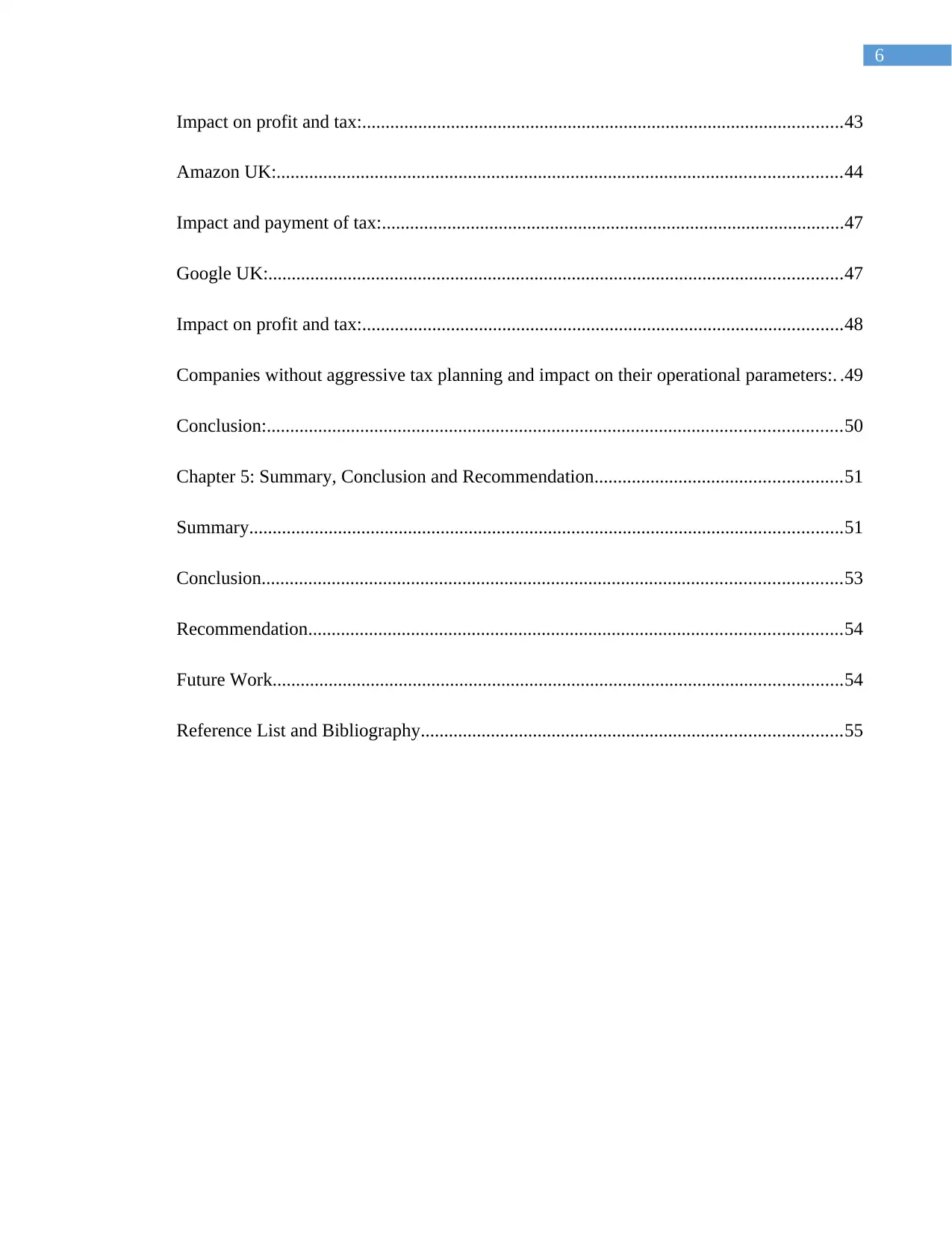
6
Impact on profit and tax:.......................................................................................................43
Amazon UK:.........................................................................................................................44
Impact and payment of tax:...................................................................................................47
Google UK:...........................................................................................................................47
Impact on profit and tax:.......................................................................................................48
Companies without aggressive tax planning and impact on their operational parameters:. .49
Conclusion:...........................................................................................................................50
Chapter 5: Summary, Conclusion and Recommendation.....................................................51
Summary...............................................................................................................................51
Conclusion............................................................................................................................53
Recommendation..................................................................................................................54
Future Work..........................................................................................................................54
Reference List and Bibliography..........................................................................................55
Impact on profit and tax:.......................................................................................................43
Amazon UK:.........................................................................................................................44
Impact and payment of tax:...................................................................................................47
Google UK:...........................................................................................................................47
Impact on profit and tax:.......................................................................................................48
Companies without aggressive tax planning and impact on their operational parameters:. .49
Conclusion:...........................................................................................................................50
Chapter 5: Summary, Conclusion and Recommendation.....................................................51
Summary...............................................................................................................................51
Conclusion............................................................................................................................53
Recommendation..................................................................................................................54
Future Work..........................................................................................................................54
Reference List and Bibliography..........................................................................................55
Paraphrase This Document
Need a fresh take? Get an instant paraphrase of this document with our AI Paraphraser
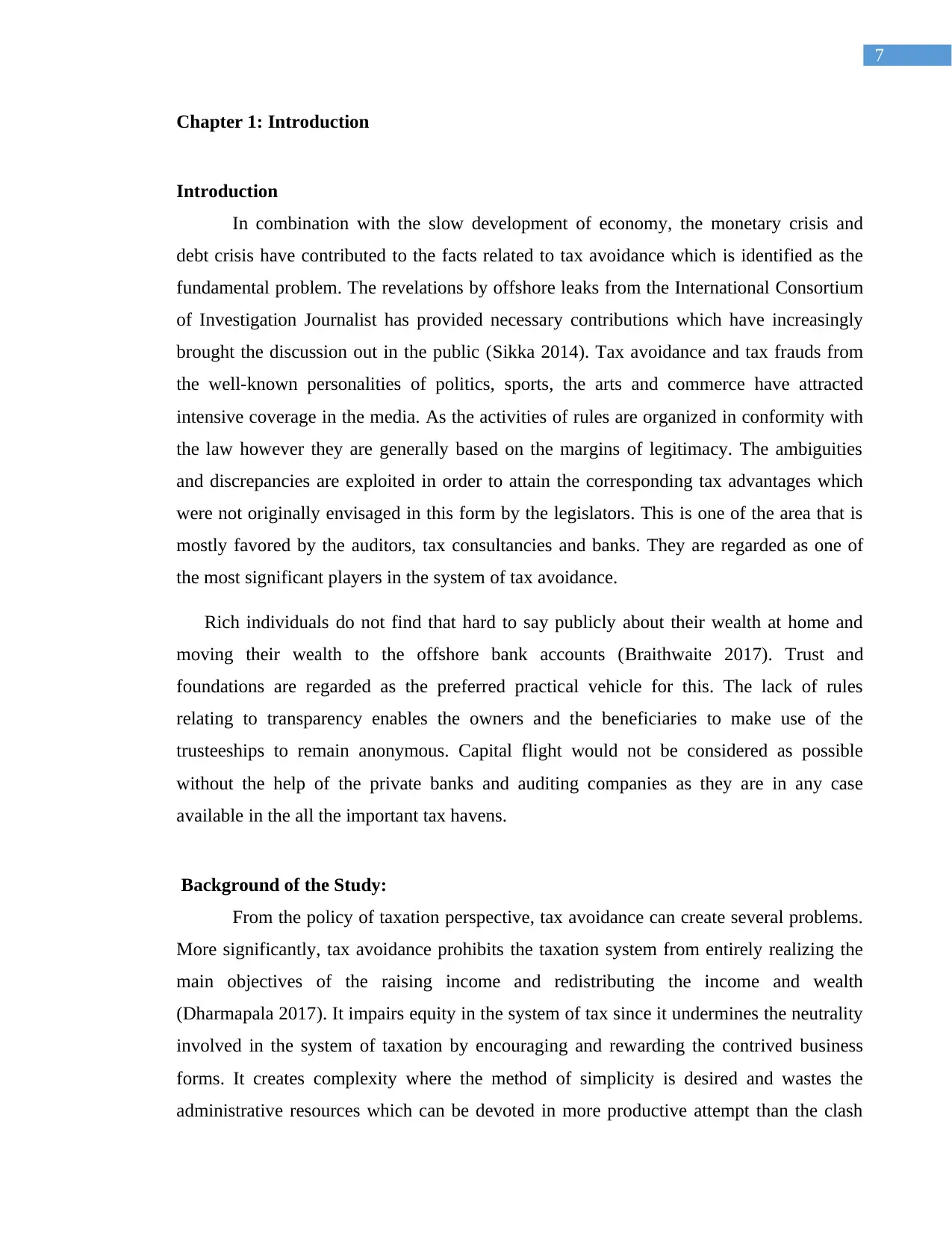
7
Chapter 1: Introduction
Introduction
In combination with the slow development of economy, the monetary crisis and
debt crisis have contributed to the facts related to tax avoidance which is identified as the
fundamental problem. The revelations by offshore leaks from the International Consortium
of Investigation Journalist has provided necessary contributions which have increasingly
brought the discussion out in the public (Sikka 2014). Tax avoidance and tax frauds from
the well-known personalities of politics, sports, the arts and commerce have attracted
intensive coverage in the media. As the activities of rules are organized in conformity with
the law however they are generally based on the margins of legitimacy. The ambiguities
and discrepancies are exploited in order to attain the corresponding tax advantages which
were not originally envisaged in this form by the legislators. This is one of the area that is
mostly favored by the auditors, tax consultancies and banks. They are regarded as one of
the most significant players in the system of tax avoidance.
Rich individuals do not find that hard to say publicly about their wealth at home and
moving their wealth to the offshore bank accounts (Braithwaite 2017). Trust and
foundations are regarded as the preferred practical vehicle for this. The lack of rules
relating to transparency enables the owners and the beneficiaries to make use of the
trusteeships to remain anonymous. Capital flight would not be considered as possible
without the help of the private banks and auditing companies as they are in any case
available in the all the important tax havens.
Background of the Study:
From the policy of taxation perspective, tax avoidance can create several problems.
More significantly, tax avoidance prohibits the taxation system from entirely realizing the
main objectives of the raising income and redistributing the income and wealth
(Dharmapala 2017). It impairs equity in the system of tax since it undermines the neutrality
involved in the system of taxation by encouraging and rewarding the contrived business
forms. It creates complexity where the method of simplicity is desired and wastes the
administrative resources which can be devoted in more productive attempt than the clash
Chapter 1: Introduction
Introduction
In combination with the slow development of economy, the monetary crisis and
debt crisis have contributed to the facts related to tax avoidance which is identified as the
fundamental problem. The revelations by offshore leaks from the International Consortium
of Investigation Journalist has provided necessary contributions which have increasingly
brought the discussion out in the public (Sikka 2014). Tax avoidance and tax frauds from
the well-known personalities of politics, sports, the arts and commerce have attracted
intensive coverage in the media. As the activities of rules are organized in conformity with
the law however they are generally based on the margins of legitimacy. The ambiguities
and discrepancies are exploited in order to attain the corresponding tax advantages which
were not originally envisaged in this form by the legislators. This is one of the area that is
mostly favored by the auditors, tax consultancies and banks. They are regarded as one of
the most significant players in the system of tax avoidance.
Rich individuals do not find that hard to say publicly about their wealth at home and
moving their wealth to the offshore bank accounts (Braithwaite 2017). Trust and
foundations are regarded as the preferred practical vehicle for this. The lack of rules
relating to transparency enables the owners and the beneficiaries to make use of the
trusteeships to remain anonymous. Capital flight would not be considered as possible
without the help of the private banks and auditing companies as they are in any case
available in the all the important tax havens.
Background of the Study:
From the policy of taxation perspective, tax avoidance can create several problems.
More significantly, tax avoidance prohibits the taxation system from entirely realizing the
main objectives of the raising income and redistributing the income and wealth
(Dharmapala 2017). It impairs equity in the system of tax since it undermines the neutrality
involved in the system of taxation by encouraging and rewarding the contrived business
forms. It creates complexity where the method of simplicity is desired and wastes the
administrative resources which can be devoted in more productive attempt than the clash
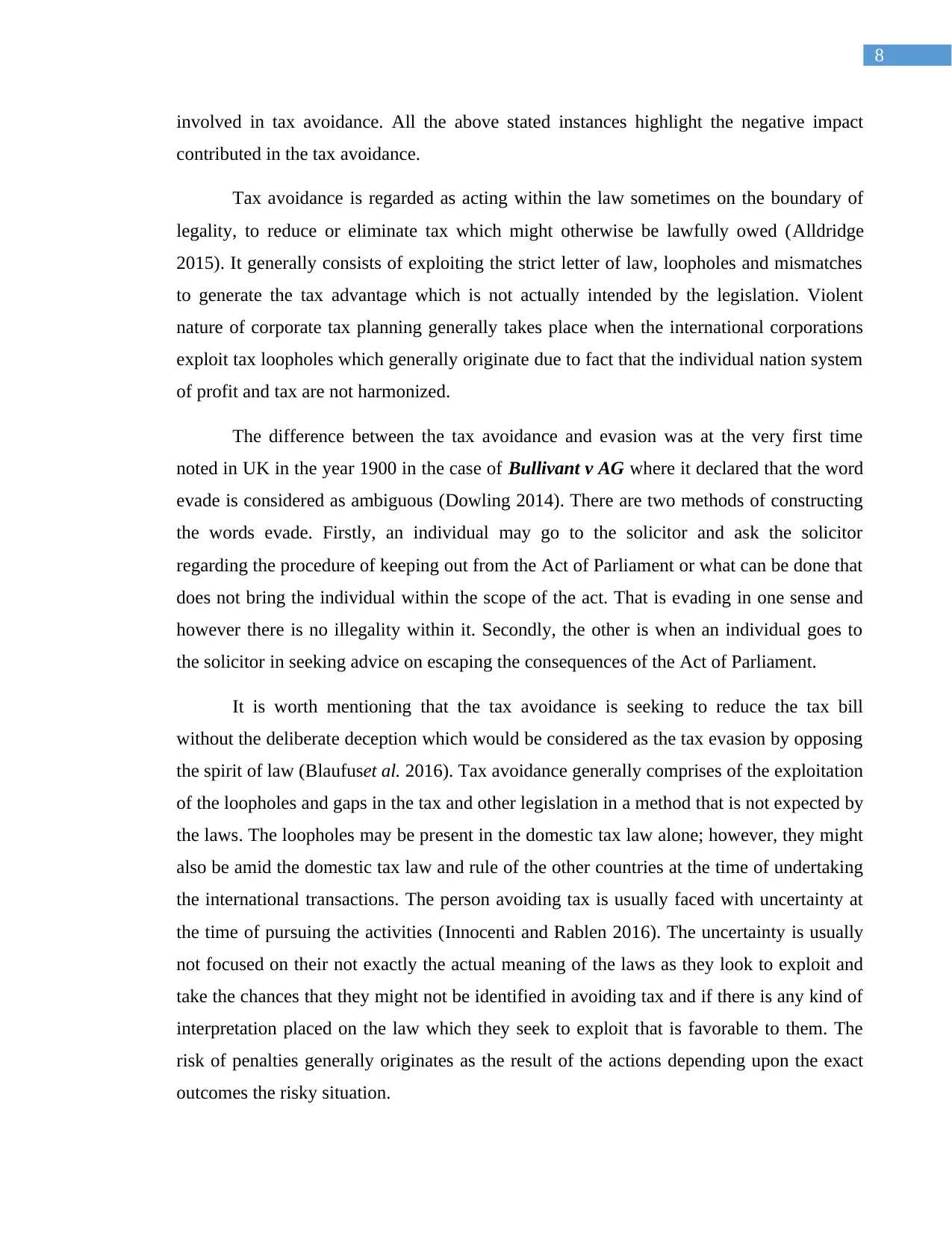
8
involved in tax avoidance. All the above stated instances highlight the negative impact
contributed in the tax avoidance.
Tax avoidance is regarded as acting within the law sometimes on the boundary of
legality, to reduce or eliminate tax which might otherwise be lawfully owed (Alldridge
2015). It generally consists of exploiting the strict letter of law, loopholes and mismatches
to generate the tax advantage which is not actually intended by the legislation. Violent
nature of corporate tax planning generally takes place when the international corporations
exploit tax loopholes which generally originate due to fact that the individual nation system
of profit and tax are not harmonized.
The difference between the tax avoidance and evasion was at the very first time
noted in UK in the year 1900 in the case of Bullivant v AG where it declared that the word
evade is considered as ambiguous (Dowling 2014). There are two methods of constructing
the words evade. Firstly, an individual may go to the solicitor and ask the solicitor
regarding the procedure of keeping out from the Act of Parliament or what can be done that
does not bring the individual within the scope of the act. That is evading in one sense and
however there is no illegality within it. Secondly, the other is when an individual goes to
the solicitor in seeking advice on escaping the consequences of the Act of Parliament.
It is worth mentioning that the tax avoidance is seeking to reduce the tax bill
without the deliberate deception which would be considered as the tax evasion by opposing
the spirit of law (Blaufuset al. 2016). Tax avoidance generally comprises of the exploitation
of the loopholes and gaps in the tax and other legislation in a method that is not expected by
the laws. The loopholes may be present in the domestic tax law alone; however, they might
also be amid the domestic tax law and rule of the other countries at the time of undertaking
the international transactions. The person avoiding tax is usually faced with uncertainty at
the time of pursuing the activities (Innocenti and Rablen 2016). The uncertainty is usually
not focused on their not exactly the actual meaning of the laws as they look to exploit and
take the chances that they might not be identified in avoiding tax and if there is any kind of
interpretation placed on the law which they seek to exploit that is favorable to them. The
risk of penalties generally originates as the result of the actions depending upon the exact
outcomes the risky situation.
involved in tax avoidance. All the above stated instances highlight the negative impact
contributed in the tax avoidance.
Tax avoidance is regarded as acting within the law sometimes on the boundary of
legality, to reduce or eliminate tax which might otherwise be lawfully owed (Alldridge
2015). It generally consists of exploiting the strict letter of law, loopholes and mismatches
to generate the tax advantage which is not actually intended by the legislation. Violent
nature of corporate tax planning generally takes place when the international corporations
exploit tax loopholes which generally originate due to fact that the individual nation system
of profit and tax are not harmonized.
The difference between the tax avoidance and evasion was at the very first time
noted in UK in the year 1900 in the case of Bullivant v AG where it declared that the word
evade is considered as ambiguous (Dowling 2014). There are two methods of constructing
the words evade. Firstly, an individual may go to the solicitor and ask the solicitor
regarding the procedure of keeping out from the Act of Parliament or what can be done that
does not bring the individual within the scope of the act. That is evading in one sense and
however there is no illegality within it. Secondly, the other is when an individual goes to
the solicitor in seeking advice on escaping the consequences of the Act of Parliament.
It is worth mentioning that the tax avoidance is seeking to reduce the tax bill
without the deliberate deception which would be considered as the tax evasion by opposing
the spirit of law (Blaufuset al. 2016). Tax avoidance generally comprises of the exploitation
of the loopholes and gaps in the tax and other legislation in a method that is not expected by
the laws. The loopholes may be present in the domestic tax law alone; however, they might
also be amid the domestic tax law and rule of the other countries at the time of undertaking
the international transactions. The person avoiding tax is usually faced with uncertainty at
the time of pursuing the activities (Innocenti and Rablen 2016). The uncertainty is usually
not focused on their not exactly the actual meaning of the laws as they look to exploit and
take the chances that they might not be identified in avoiding tax and if there is any kind of
interpretation placed on the law which they seek to exploit that is favorable to them. The
risk of penalties generally originates as the result of the actions depending upon the exact
outcomes the risky situation.
⊘ This is a preview!⊘
Do you want full access?
Subscribe today to unlock all pages.

Trusted by 1+ million students worldwide
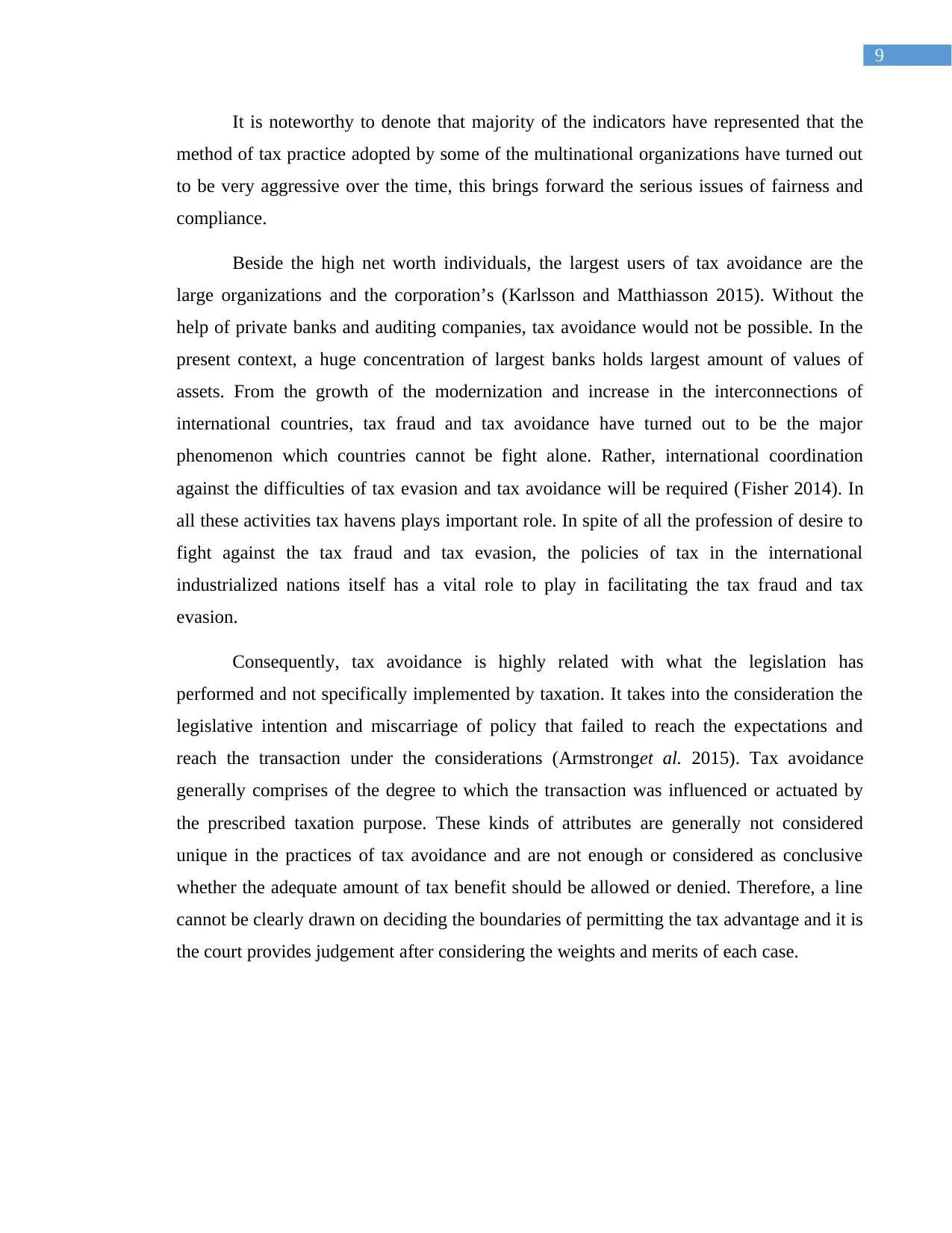
9
It is noteworthy to denote that majority of the indicators have represented that the
method of tax practice adopted by some of the multinational organizations have turned out
to be very aggressive over the time, this brings forward the serious issues of fairness and
compliance.
Beside the high net worth individuals, the largest users of tax avoidance are the
large organizations and the corporation’s (Karlsson and Matthiasson 2015). Without the
help of private banks and auditing companies, tax avoidance would not be possible. In the
present context, a huge concentration of largest banks holds largest amount of values of
assets. From the growth of the modernization and increase in the interconnections of
international countries, tax fraud and tax avoidance have turned out to be the major
phenomenon which countries cannot be fight alone. Rather, international coordination
against the difficulties of tax evasion and tax avoidance will be required (Fisher 2014). In
all these activities tax havens plays important role. In spite of all the profession of desire to
fight against the tax fraud and tax evasion, the policies of tax in the international
industrialized nations itself has a vital role to play in facilitating the tax fraud and tax
evasion.
Consequently, tax avoidance is highly related with what the legislation has
performed and not specifically implemented by taxation. It takes into the consideration the
legislative intention and miscarriage of policy that failed to reach the expectations and
reach the transaction under the considerations (Armstronget al. 2015). Tax avoidance
generally comprises of the degree to which the transaction was influenced or actuated by
the prescribed taxation purpose. These kinds of attributes are generally not considered
unique in the practices of tax avoidance and are not enough or considered as conclusive
whether the adequate amount of tax benefit should be allowed or denied. Therefore, a line
cannot be clearly drawn on deciding the boundaries of permitting the tax advantage and it is
the court provides judgement after considering the weights and merits of each case.
It is noteworthy to denote that majority of the indicators have represented that the
method of tax practice adopted by some of the multinational organizations have turned out
to be very aggressive over the time, this brings forward the serious issues of fairness and
compliance.
Beside the high net worth individuals, the largest users of tax avoidance are the
large organizations and the corporation’s (Karlsson and Matthiasson 2015). Without the
help of private banks and auditing companies, tax avoidance would not be possible. In the
present context, a huge concentration of largest banks holds largest amount of values of
assets. From the growth of the modernization and increase in the interconnections of
international countries, tax fraud and tax avoidance have turned out to be the major
phenomenon which countries cannot be fight alone. Rather, international coordination
against the difficulties of tax evasion and tax avoidance will be required (Fisher 2014). In
all these activities tax havens plays important role. In spite of all the profession of desire to
fight against the tax fraud and tax evasion, the policies of tax in the international
industrialized nations itself has a vital role to play in facilitating the tax fraud and tax
evasion.
Consequently, tax avoidance is highly related with what the legislation has
performed and not specifically implemented by taxation. It takes into the consideration the
legislative intention and miscarriage of policy that failed to reach the expectations and
reach the transaction under the considerations (Armstronget al. 2015). Tax avoidance
generally comprises of the degree to which the transaction was influenced or actuated by
the prescribed taxation purpose. These kinds of attributes are generally not considered
unique in the practices of tax avoidance and are not enough or considered as conclusive
whether the adequate amount of tax benefit should be allowed or denied. Therefore, a line
cannot be clearly drawn on deciding the boundaries of permitting the tax advantage and it is
the court provides judgement after considering the weights and merits of each case.
Paraphrase This Document
Need a fresh take? Get an instant paraphrase of this document with our AI Paraphraser
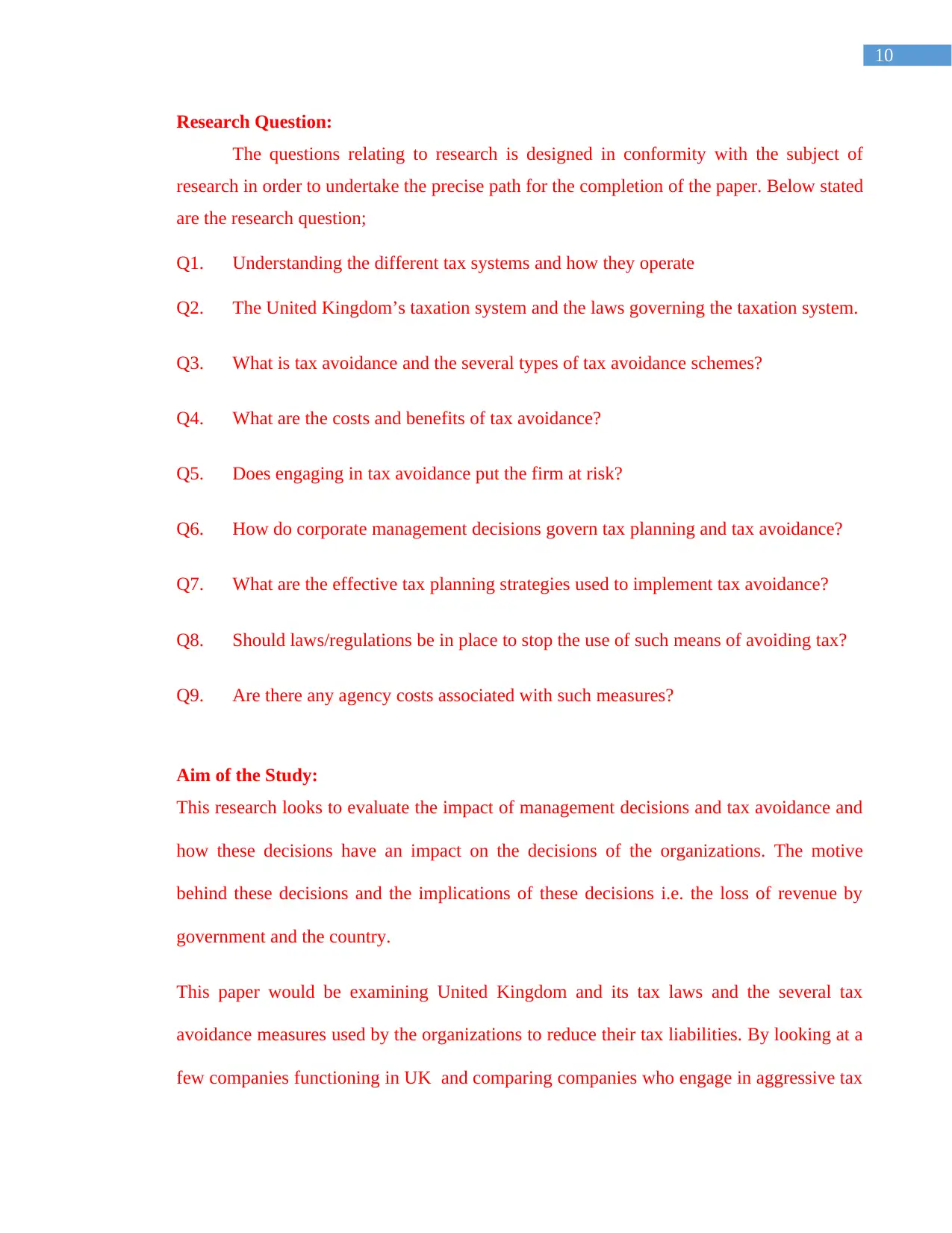
10
Research Question:
The questions relating to research is designed in conformity with the subject of
research in order to undertake the precise path for the completion of the paper. Below stated
are the research question;
Q1. Understanding the different tax systems and how they operate
Q2. The United Kingdom’s taxation system and the laws governing the taxation system.
Q3. What is tax avoidance and the several types of tax avoidance schemes?
Q4. What are the costs and benefits of tax avoidance?
Q5. Does engaging in tax avoidance put the firm at risk?
Q6. How do corporate management decisions govern tax planning and tax avoidance?
Q7. What are the effective tax planning strategies used to implement tax avoidance?
Q8. Should laws/regulations be in place to stop the use of such means of avoiding tax?
Q9. Are there any agency costs associated with such measures?
Aim of the Study:
This research looks to evaluate the impact of management decisions and tax avoidance and
how these decisions have an impact on the decisions of the organizations. The motive
behind these decisions and the implications of these decisions i.e. the loss of revenue by
government and the country.
This paper would be examining United Kingdom and its tax laws and the several tax
avoidance measures used by the organizations to reduce their tax liabilities. By looking at a
few companies functioning in UK and comparing companies who engage in aggressive tax
Research Question:
The questions relating to research is designed in conformity with the subject of
research in order to undertake the precise path for the completion of the paper. Below stated
are the research question;
Q1. Understanding the different tax systems and how they operate
Q2. The United Kingdom’s taxation system and the laws governing the taxation system.
Q3. What is tax avoidance and the several types of tax avoidance schemes?
Q4. What are the costs and benefits of tax avoidance?
Q5. Does engaging in tax avoidance put the firm at risk?
Q6. How do corporate management decisions govern tax planning and tax avoidance?
Q7. What are the effective tax planning strategies used to implement tax avoidance?
Q8. Should laws/regulations be in place to stop the use of such means of avoiding tax?
Q9. Are there any agency costs associated with such measures?
Aim of the Study:
This research looks to evaluate the impact of management decisions and tax avoidance and
how these decisions have an impact on the decisions of the organizations. The motive
behind these decisions and the implications of these decisions i.e. the loss of revenue by
government and the country.
This paper would be examining United Kingdom and its tax laws and the several tax
avoidance measures used by the organizations to reduce their tax liabilities. By looking at a
few companies functioning in UK and comparing companies who engage in aggressive tax
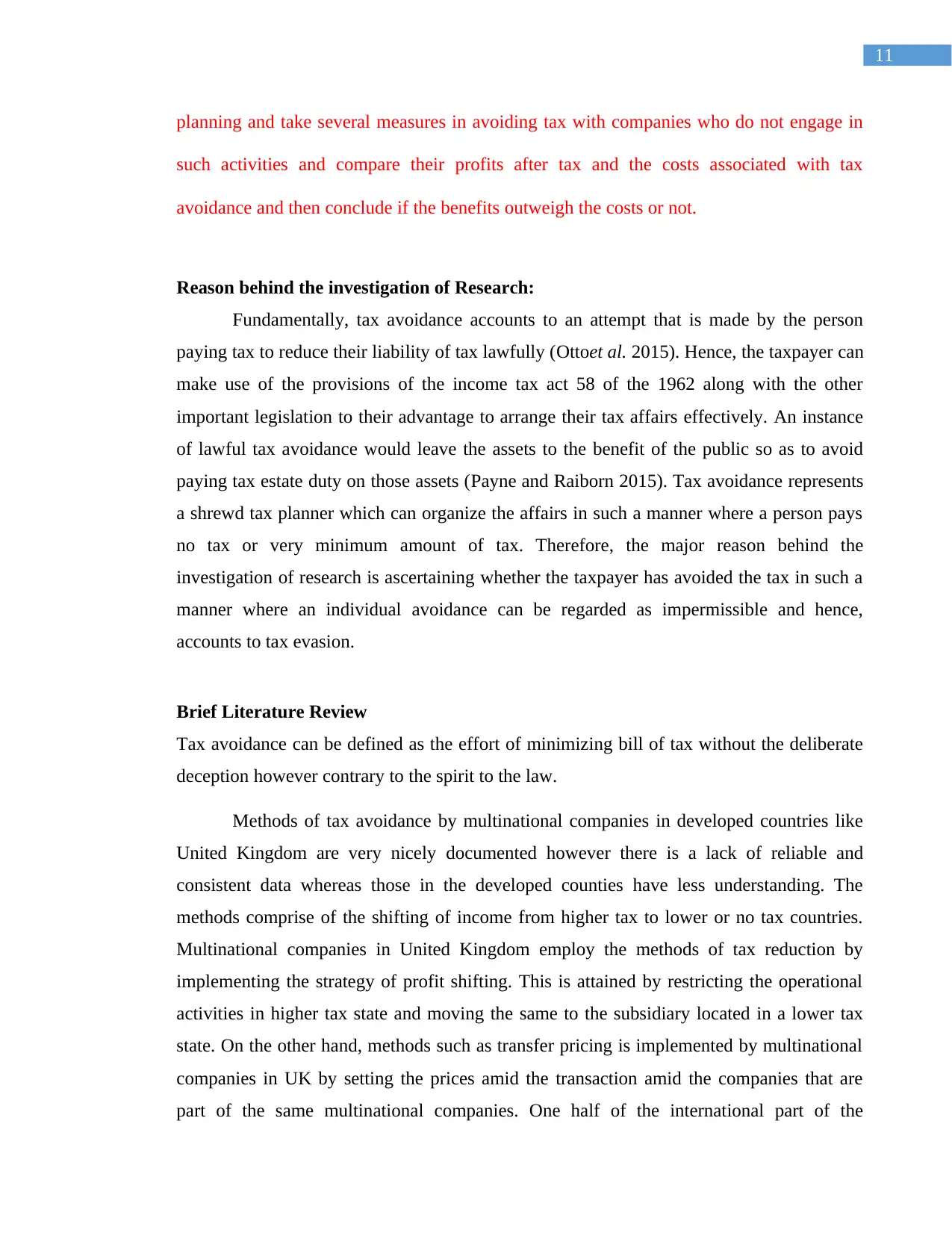
11
planning and take several measures in avoiding tax with companies who do not engage in
such activities and compare their profits after tax and the costs associated with tax
avoidance and then conclude if the benefits outweigh the costs or not.
Reason behind the investigation of Research:
Fundamentally, tax avoidance accounts to an attempt that is made by the person
paying tax to reduce their liability of tax lawfully (Ottoet al. 2015). Hence, the taxpayer can
make use of the provisions of the income tax act 58 of the 1962 along with the other
important legislation to their advantage to arrange their tax affairs effectively. An instance
of lawful tax avoidance would leave the assets to the benefit of the public so as to avoid
paying tax estate duty on those assets (Payne and Raiborn 2015). Tax avoidance represents
a shrewd tax planner which can organize the affairs in such a manner where a person pays
no tax or very minimum amount of tax. Therefore, the major reason behind the
investigation of research is ascertaining whether the taxpayer has avoided the tax in such a
manner where an individual avoidance can be regarded as impermissible and hence,
accounts to tax evasion.
Brief Literature Review
Tax avoidance can be defined as the effort of minimizing bill of tax without the deliberate
deception however contrary to the spirit to the law.
Methods of tax avoidance by multinational companies in developed countries like
United Kingdom are very nicely documented however there is a lack of reliable and
consistent data whereas those in the developed counties have less understanding. The
methods comprise of the shifting of income from higher tax to lower or no tax countries.
Multinational companies in United Kingdom employ the methods of tax reduction by
implementing the strategy of profit shifting. This is attained by restricting the operational
activities in higher tax state and moving the same to the subsidiary located in a lower tax
state. On the other hand, methods such as transfer pricing is implemented by multinational
companies in UK by setting the prices amid the transaction amid the companies that are
part of the same multinational companies. One half of the international part of the
planning and take several measures in avoiding tax with companies who do not engage in
such activities and compare their profits after tax and the costs associated with tax
avoidance and then conclude if the benefits outweigh the costs or not.
Reason behind the investigation of Research:
Fundamentally, tax avoidance accounts to an attempt that is made by the person
paying tax to reduce their liability of tax lawfully (Ottoet al. 2015). Hence, the taxpayer can
make use of the provisions of the income tax act 58 of the 1962 along with the other
important legislation to their advantage to arrange their tax affairs effectively. An instance
of lawful tax avoidance would leave the assets to the benefit of the public so as to avoid
paying tax estate duty on those assets (Payne and Raiborn 2015). Tax avoidance represents
a shrewd tax planner which can organize the affairs in such a manner where a person pays
no tax or very minimum amount of tax. Therefore, the major reason behind the
investigation of research is ascertaining whether the taxpayer has avoided the tax in such a
manner where an individual avoidance can be regarded as impermissible and hence,
accounts to tax evasion.
Brief Literature Review
Tax avoidance can be defined as the effort of minimizing bill of tax without the deliberate
deception however contrary to the spirit to the law.
Methods of tax avoidance by multinational companies in developed countries like
United Kingdom are very nicely documented however there is a lack of reliable and
consistent data whereas those in the developed counties have less understanding. The
methods comprise of the shifting of income from higher tax to lower or no tax countries.
Multinational companies in United Kingdom employ the methods of tax reduction by
implementing the strategy of profit shifting. This is attained by restricting the operational
activities in higher tax state and moving the same to the subsidiary located in a lower tax
state. On the other hand, methods such as transfer pricing is implemented by multinational
companies in UK by setting the prices amid the transaction amid the companies that are
part of the same multinational companies. One half of the international part of the
⊘ This is a preview!⊘
Do you want full access?
Subscribe today to unlock all pages.

Trusted by 1+ million students worldwide
1 out of 83
Related Documents
Your All-in-One AI-Powered Toolkit for Academic Success.
+13062052269
info@desklib.com
Available 24*7 on WhatsApp / Email
![[object Object]](/_next/static/media/star-bottom.7253800d.svg)
Unlock your academic potential
Copyright © 2020–2025 A2Z Services. All Rights Reserved. Developed and managed by ZUCOL.




